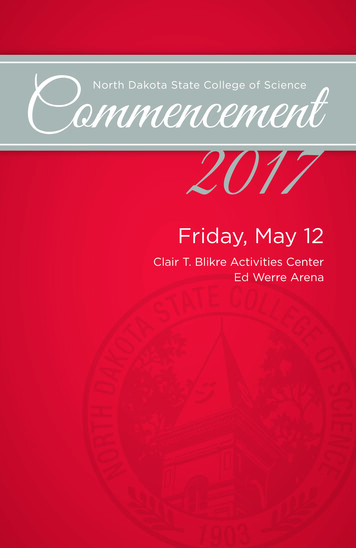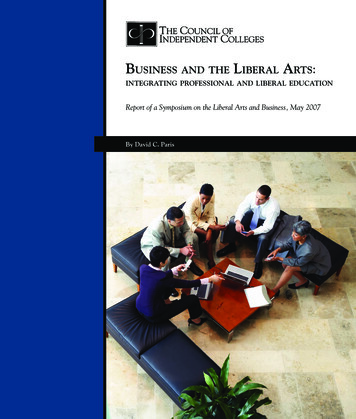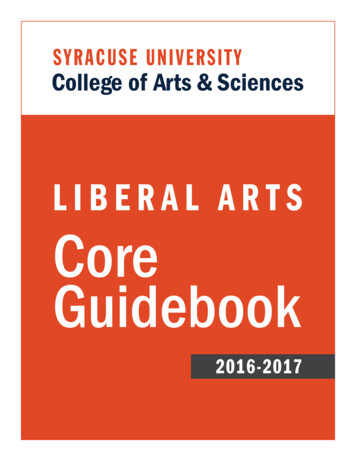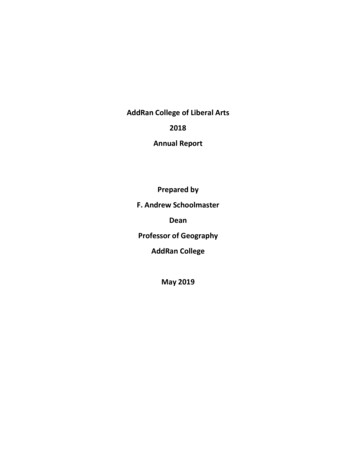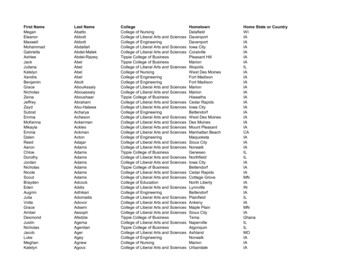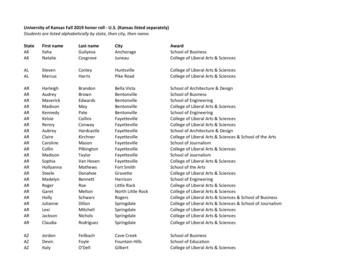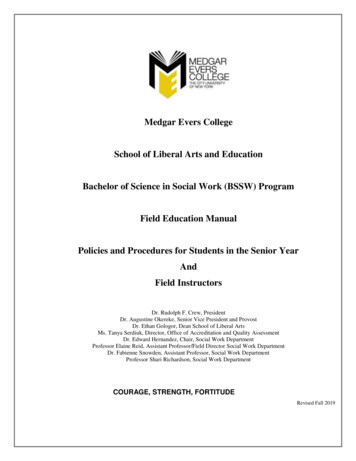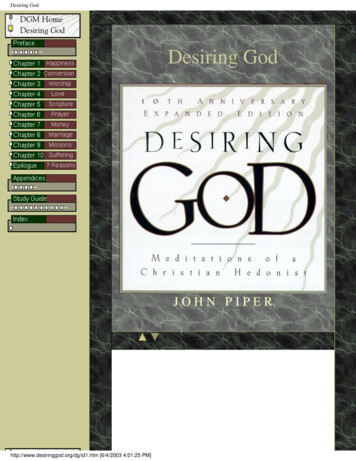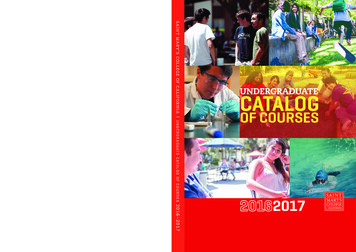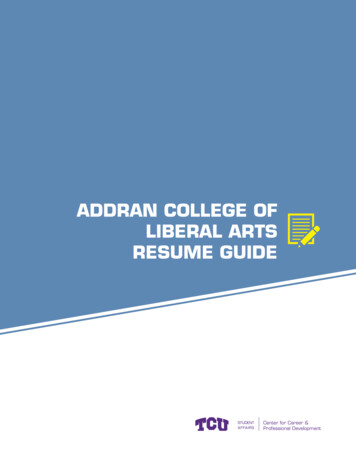
Transcription
CHRISTIAN LIBERAL ARTS HIGHER EDUCATION IN RUSSIA: A CASE STUDY OFTHE RUSSIAN-AMERICAN CHRISTIAN UNIVERSITYVictor N. Titarchuk, B.A., M.A.Dissertation Prepared for the Degree ofDOCTOR OF PHILOSOPHYUNIVERSITY OF NORTH TEXASMay 2007APPROVED:D. Barry Lumsden, Major ProfessorLinden McLaughlin, Minor ProfessorJohn Bernbaum, Committee MemberKathleen Whitson, Program DirectorJan Holden, Interim Chair of the Departmentof Counseling, Development, andHigher EducationM. Jean Keller, Dean of the College ofEducationSandra L. Terrell, Dean of the Robert B.Toulouse School of Graduate Studies
Titarchuk, Victor N., Christian Liberal Arts Higher Education in Russia: A CaseStudy of the Russian-American Christian University, Doctor of Philosophy (HigherEducation), May 2007, 307 pp., 14 tables, 24 illustrations, references, 110 titles.This is a case study of the historical development of a private Christian faithbased school of higher education in post-Soviet Russia from its conception in 1990 until2006. This bi-national school was founded as the Russian-American ChristianUniversity (RACU) in 1996. In 2003, RACU was accredited by the Russian Ministry ofEducation under the name Russko-Americansky Christiansky Institute.RACU offers two state-accredited undergraduate academic programs:1) business and economics, and 2) social work. RACU also offers a major in Englishlanguage and literature. The academic model of RACU was designed according to thetraditional American Christian liberal arts model and adapted to Russian highereducation system.The study documents the founding, vision, and growth of RACU. It providesinsight into the academic, organizational, and campus life of RACU. The study led to thecreation of an operational framework of the historical development of RACU. The studyalso provides recommendations for the development of new Christian liberal artscolleges and universities based on the experience and the underlying structure ofRACU.
Copyright 2007byVictor N. Titarchukii
TABLE OF CONTENTSPageLIST OF TABLES.viLIST OF ILLUSTRATIONS . viiChapterI.INTRODUCTION . 1Religious Freedom during . 2Perestroika and Glasnost (1987 – 1990). 2The Origins of Christian Liberal Arts in Russia. 4The Russian-American Christian University . 8Statement of the Problem . 10Purposes of the Study. 10Research Questions. 10Significance of the Study. 11Definition of Terms . 12Limitations . 13II.METHODOLOGY . 15Research Design. 15Sources of Data . 16Data Collection Procedures . 17Data Analysis . 19III.FINDINGS . 22The Gestation Period (1990 - 94) . 22The Foundational Period (1994 – 96) . 34The Developmental Period (1996 - 2006) . 41Strategic Plan (2006 – 16) . 119IV.CONCLUSIONS, SUMMARY OF FINDINGS, DISCUSSION OFFINDINGS, AND RECOMMENDATIONS . 124Conclusions . 124iii
Summary of Findings . 124Discussion of Findings . 132Recommendations . 170Recommendations for New Christian. 174Liberal Arts Colleges and Universities. 174AppendicesA.SOVIET DELEGATION. 178B.A PROTOCOL OF INTENTIONS. 180C.SOVIET-US DELEGATIONS . 183D.ENGLISH LANGUAGE INSTITUTE. 185E.RACU/US INC. CERTIFICATE OF INCORPORATION . 187F.RACU FOUNDATION AGREEMENT . 189G.CITY OF MOSCOW REGISTRATION . 202H.CHARTER (SECOND EDITION) . 204I.COURSES PRESENTED (1996 – 2000) . 223J.DESCRIPTION OF COURSES. 229K.STRATEGIC PLAN (1996 – 2006). 239L.PRESIDENT POSITION DESCRIPTION. 251M.POLICY ON CUSTOMER SERVICE . 254N.BUSINESS AND ECONOMICS CURRICULUM . 256O.SOCIAL WORK CURRICULUM . 262P.ENGLISH PROGRAM. 268Q.FINAL REPORT. 272R.EDUCATIONAL LICENSE . 281iv
S.STATE ACCREDITATION . 283T.BUSINESS AND ECONOMICS ACADEMIC PROGRAM. 285U.JESSUP REPORT . 289V.FIVE STAGES OF CONSTRUCTION IN MOSCOW . 296W.OPERATIONAL FRAMEWORK OF RACU. 299REFERENCES. 301v
LIST OF TABLESPageTable 1. Partner Colleges and Universities . 28Table 2. American Working Group . 32Table 3. First Board of Advisors . 42Table 4. Faculty (1996) . 45Table 5. Business and Economics Curriculum . 51Table 6. Cognate Core Courses. 53Table 7. Faculty (2001) . 75Table 8. Faculty (2002) . 84Table 9. Staff (2002). 86Table 10. Tuition Rates (2004 - 05). 96Table 11. Fall 2004 Semester Enrollment . 104Table 12. Tuition Rates (2006 - 07). 111Table 13. Fall 2005 Semester Enrollment . 113Table 14. Spring 2006 Semester Enrollment. 114vi
LIST OF ILLUSTRATIONSPageFigure 1. Proposed Organizational Structure . 39Figure 2. RACU Logo (1995). 41Figure 3. RACU's New Headquarters in Moscow. 54Figure 4. RACU Logo (2000). 66Figure 5. Organizational Structure . 69Figure 6. Promoting Academic Excellence. 78Figure 7. Organization Chart . 80Figure 8. Entrance (Before). 93Figure 9. Entrance (After). 93Figure 10. New Campus Model. 94Figure 11. State Accreditation Seal . 95Figure 12. Proposed Organization Chart. 100Figure 13. RACU Timeline (1990 - 2006) . 125Figure 14. Operational Framework of RACU: Leadership . 136Figure 15. Operational Framework of RACU: Identity (Public Relations) . 138Figure 16. Operational Framework of RACU: Identity (Quality & Scholarship). 140Figure 17. Operational Framework of RACU: Identity (RACU/US Inc.) . 142Figure 18. Operational Framework of RACU: Finances . 144Figure 19. Operational Framework of RACU: Partners . 149Figure 20. Operational Framework of RACU: Academic Programs and Curricula . 153Figure 21. Operational Framework of RACU: Faculty and Staff. 157vii
Figure 22. Operational Framework of RACU: Students. 162Figure 23. Operational Framework of RACU: Campus . 166Figure 24. Operational Framework of RACU: Outreach . 170viii
CHAPTER IINTRODUCTIONFollowing the October Revolution of 1917, the Bolsheviks took full control ofhigher education in Russia. Their leaders adopted a materialistic ideology (Thrower,1983) based on the teachings of Karl Marx, Friedrich Engels, and Vladimir Ulyanov(Lenin). This new ideology was propagated throughout all levels of society, includinghigher education. It was well-developed and had its own methodology for the study ofreligion and atheism.The church and religion have played central roles in Russia (Prizel, 1997). Statepolicy regarding religious liberty and legal rights has been important since A.D. 988,when the kingdom of Kievan-Rus officially accepted Christianity (Reid, 1997).Since the materialistic perspective of the Bolsheviks excluded religion from itsvalues, Christians have experienced marginalization both in the work place and inhigher education (Anderson, 1994). Lenin, leader of the Bolsheviks, believed that one ofthe vilest things existing in the world is religion because it attempts to replace the officialstate priests by the priests of moral conviction (Lenin, 1933). The influence that thechurch had on higher education was gradually eliminated. The Bolsheviks abolished allcourses on religion that had been integrated into the curricula of higher educationinstitutions in Tsarist Russia.Later, scientific atheism was introduced into the curricula as a major course. Itwas designed to teach students life perspectives and the foundations of an atheisticworldview (Thrower, 1983). Christian studies were highly discouraged and viewed asactive opposition to the official ideology of the Communist Party.1
Over time, the higher education system abandoned academic freedom. As aresult, courses like the Foundations of Leninism, Scientific Materialism, the History ofthe Soviet Communist Party, and other courses that promoted Communist ideologyreplaced all Christian courses taught in Russian institutes and universities prior to theGreat October Revolution.Over the years, Russian higher education came under the full ideological controlof the Communist Party. Christians were prohibited from entering, learning, andteaching in state-owned institutions of higher education. However, beginning in 1987,repressive political control was slowly loosened and Christians were able to enterinstitutes or universities.During the Soviet period, Christian institutions of higher education wereprohibited from offering academic services and granting degrees. Only when the Sovietgovernment passed long-awaited legislation on freedom of conscience and religiousorganizations in 1990 did the study of religion in higher education assume newimportance (Sutton, 1996).Religious Freedom duringPerestroika and Glasnost (1987 – 1990)The Gorbachev era of reform intended to reverse economic decay but also gavevoice to popular pressure for religious liberty (Biddulph, 1995). It was the beginning of anew era. The demise of the Soviet Union was symbolically depicted in the demolition ofthe Berlin Wall in 1989. Schmemann (1989) reported the event in the New York Timesand described how ordinary citizens with hammers pounded to pieces the symbol ofCommunism’s atheist iconography.2
The number of visiting Christians increased dramatically as the result of thepolitical climate change and the new laws that permitted western tourists to enter theSoviet Union. Missionaries had waited for this opportunity for a long time. They came toshare their faith with spiritually hungry Russians. Among other Christian organizations,the Slavic Gospel Association (SGA) established close relationships with governmentofficials who were open to cooperation. Russian educators realized the need for changeand educational reform and were seeking new educational exchanges (Deyneka, 1990).During the Gorbachev’s Perestroyka period, higher education curricula began tochange slowly in state-owned institutions. The Foundations of Scientific Atheism as asubject was slowly eliminated throughout the Soviet system. The erosion of centralauthority within the Communist Party led to a loss of interest in imposing atheism inhigher education. The provision of courses in religion became possible (Sutton, 1996).In 1990, the Soviet government adopted progressive laws affecting freedom ofconscience and religion. Two of the first laws included a law that permitted the right ofreligious exercise and organization (Smith, 1996). Legislative moves by the Sovietgovernment toward religious freedom and privatization of government-owned propertyallowed for the creation of private higher education institutions regardless of theirpurpose.The evangelical movement in the Soviet Union, enabled by western financial andacademic support, began to generate momentum that led to the establishment ofseveral private Christian schools. The beginning of the history of Christian highereducation in Russia is linked to the establishment of several Bible schools andseminaries in the former Soviet Union. Among these were Zaokskaya Duchovnaya3
Academia (Zaoksk Spiritual Academy), established in December 1988 (Kulakov, 1993),and Odessa Bible School, established in August 1989 (Sannikov, 2001). SovietChristians received an opportunity to fulfill their dreams and to prepare for Christianministry in local churches in the newly established private Christian higher educationschools.Private Christian higher education schools began offering primarily pastoral andtheological training. These schools were directly involved in training pastors, Bibleteachers, worship leaders, and missionaries (Kulakov, 1993; Sannikov, 2001).Many people in the former Soviet Union associated Christian higher educationwith preparation for ministry within local churches. Some thought that Christian highereducation was about historical studies of Christianity and its dogmatic teachings. Thiswas the case until a new type of Christian higher education with an emphasis on theliberal arts was introduced by American Christian educators.The Origins of Christian Liberal Arts in RussiaChristian liberal arts higher education in Russia began to develop during theearly 1990s as one of many Soviet educational reforms. It started with an interculturalexchange between Russian and American educators.After an initial visit to Moscow in March 1990, the Vice President of the ChristianCollege Coalition (CCC), Dr. Karen Longman, received several official invitations for theCoalition to visit the Russian Soviet Federated Socialist Republic (RSFSR). TheCoalition wanted to seize the opportunity to have a long-term influence on the SovietUnion through Christian higher education. A delegation of leading Soviet educators and4
members of the Ministry of Soviet Higher and Special Education was invited to theUnited States. The rationale for the invitation was to introduce Russian educators toChristian liberal arts curricula on campuses of the Coalition’s faith-based liberal artscolleges and universities.In September 1990, a group of sixteen Russian educators came to the UnitedStates. Delegates attended special workshops on American higher education and onChristian liberal arts education. They learned that Christian liberal arts curriculaintegrate subject matter with the Christian faith across the entire curricula.In light of contemporary political changes in Russia and the popularity of faithamong Russian students, the delegates were impressed with the quality and integrationof moral and spiritual values within American Christian higher education. The Russiandelegation consisted mostly of rectors and vice-rectors from Russian technicaluniversities. As part of the Soviet educational reform initiatives, delegates wereinterested in the development of a new emphasis for existing professional trainingcurricula that would enhance and strengthen the humanitarian side of technical highereducation. After the visit to America, many delegates were convinced that they hadfound what was lacking in Russian professional higher education. At the end of the visit,a Protocol of Intentions between universities and institutions within the Russian SovietFederated Socialist Republic (RSFSR) and the Christian College Coalition (Washington,DC) was signed. Both sides agreed to improve relationships between the two nations,promote cooperative educational programs between their organizations, and enhancetheir spiritual, cultural, and scientific development. Delegates agreed to share5
perspectives, research, and programs among their students, faculty, and administratorsof participating institutions of higher learning.In October 1990, a group of American educators made a follow-up visit toRussia. The Coalition delegation consisted of thirteen representatives from Coalitioninstitutions. These American delegates visited a wide variety of Russian highereducation institutions and were delighted by the eagerness of Russian educators tocooperate with member institutions of the Christian College Coalition.At the end of the visit, Dr. John Bernbaum, Vice President of the Coalition andleader of the American delegation, along with two other American delegates, wereinvited to meet with high-ranking officials of the State Committee on Science and HigherEducation of the RSFSR. The primary purpose of the meeting was to facilitate anincrease in the numbers of exchange agreements between Coalition memberinstitutions and Russian institutions. During the meeting, the first Vice-Chairman of theState Committee on Science and Higher Education of the Russian Republic, Vladimir G.Kinelev, advanced an official proposal to establish a Christian college in Russia. Theidea of a Christian liberal arts higher education institution in Russia was planted.One of the main reasons for Christian liberal arts education in Russia was thegrowing interest in religion and morality among its students. Russian educators wantedto have an American Christian liberal arts college that offers a different kind ofeducation to students in Russia. They wanted to have an example of a Christian liberalarts university in their country. They desired to integrate liberal arts curricula and thepositive features of campus life of member institutions of the Coalition into Russianinstitutions of higher learning.6
After meeting with Kinelev, Bernbaum was convinced that an American Christianliberal arts college in Russia was feasible. Russian higher education officials wanted tostart immediately by providing a building for a college and housing for American faculty.However, after a report to the leadership of CCC, Bernbaum learned that the Coalition’sBoard of Directors was not ready to support a full-sized Christian college in Russia.As Vice President of the Coalition, Bernbaum continued to actively developeducational exchange initiatives for the next several years. However, he believed thatChristian liberal arts higher education was a key to Russia’s leadership development.Bernbaum was convinced that the timing was strategic and the founding of a Christianliberal arts university was only a matter of time.After repeated visits by the American delegation, personal relationships betweeneducators in both countries strengthened; friendships deepened, and educationalbridges were built. Several bilateral agreements were signed; these provided afoundation for student and faculty exchange programs in 1991 – 92.During that period, some changes involving freedom of religion and Sovieteducational initiatives occurred. As a result, new opportunities in Russia were created.However, the political situation was volatile. The Soviet Union was disintegrating andRussia was going through political struggles. Many educational officials vacated theirpositions and leadership changes within the Russian higher education systemsignificantly delayed the founding of a Christian college in Russia. However, six yearslater, the Russian-American Christian University’s (RACU) Board of Trustees signed afoundation agreement in Moscow, Russia. Thus began the first private bi-national faithbased liberal arts university in Russia.7
The Russian-American Christian UniversityRACU opened its doors in Moscow, Russia, for its first freshmen class in fall1996. Twenty-four students entered a new university founded as a bi-national Christianeducational organization. They did not know that it would take them almost 6 years toreceive a fully accredited undergraduate degree. All they knew was that this universityhad American and Russian Christian faculty who were dedicated to offering the bestChristian liberal arts higher education available in Russia at that time. These studentsknew they were taking a risk, but they believed that attaining a Christian liberal artseducation was better than earning a diploma from an unaccredited Russian-Americanuniversity. Fortunately, from the very beginning, RACU’s leadership was dedicated toachieving full accreditation from the Russian Ministry of Higher Education.When RACU began recruiting, many Russian people misunderstood the conceptof a Christian liberal arts higher education. They thought that RACU was just anotherAmerican school that offered religious training and preparation for the ministry in localProtestant churches. From the beginning, RACU was a Russian-American partnershiprather than an American establishment. RACU insisted on professional training basedon Christian principles and ethical standards. It was the first bi-national Christianuniversity in Russia to offer a four-year Christian liberal arts program integrated withprofessional preparation in the fields of business and economics, social work, andEnglish language and literature. In addition to professional training, computer literacy,and competency in English, RACU graduates are grounded in Christian ethics andmorality. The academic model of RACU was designed according to the traditional8
American liberal arts model adapted to the Russian system of higher education. RACUis now fully accredited by the Russian Ministry of Education.RACU is a distinctively Christian faith-based school of higher educationdedicated to graduating outstanding Christian leaders and active participants in localcommunities and Russian society. Some of the graduates have already achievedoutstanding accomplishments and provide RACU with a good reputation. From 2001through 2006, RACU graduated one hundred twenty-four students.Four major goals are at the core of RACU’s mission statement: 1) to engageRussian students in a vigorous liberal arts education, 2) to produce high qualityChristian scholarship by faculty and students, 3) to create an educational community ofscholars, and 4) to offer Russian society a credible intellectual testimony.RACU is a continually evolving university. Because RACU has developed adistinct bi-national organizational structure, with administration and faculty of RACUfrom both educational systems, this is truly a unique collegiate community. This binational academic environment poses many challenges that offer multiple opportunitiesfor institutional development. RACU utilizes liberal arts learning to promote thedevelopment of every student for a fulfilled life of leadership, service, and personalachievement.Political, economic, and contemporary social changes in Russian society havecreated a unique environment for developing a new worldview among the Russianpeople. To equip Russian Christians to contribute to Russian society and to localcommunities, RACU now offers professional training according to the model of aChristian liberal arts higher education. This kind of training equips students with a9
distinct Christian worldview based on historic Christian traditions of Russia, Europe, andAmerica. It provides opportunities for students to acquire a solid grasp of subject matter,integrate Christian faith and learning, and acquire competence in critical thinking andproblem solving. The growing demand for Christian liberal arts higher education is oneof the major factors contributing to RACU’s development.Statement of the ProblemThe problem of this study was the genesis and historical development of theRussian-American Christian University from its conception in 1990 until 2006.Purposes of the StudyFive major purposes directed this qualitative historical study: 1) identify the majorkey events in the development of RACU, 2) discover the academic programs andcurricula of RACU, 3) characterize the educational clientele of RACU, 4) investigateRACU’s plans for future development, and 5) create an operational framework ofhistorical development of RACU.Research QuestionsThe research questions for this study included the following:1. What were the major key events in the development of RACU?2. What have been the academic programs and curricula of RACU?3. Who has been the educational clientele of RACU?4. What are the plans for future developments of RACU?10
5. What is an operational framework of the historical development of RACU?Significance of the StudyThe Russian-American Christian University is a private (non-government)Christian liberal arts higher education institution accredited by the Russian Ministry ofEducation. RACU has two fully accredited programs in business and economics, andsocial work. It also offers a major in English language and literature, but this academicprogram was not state-accredited at the time of this writing.RACU is the first fully accredited school to offer higher education based onChristian liberal arts programs developed in the United States. Although RACUoccupies a very narrow niche in the academic market of Russia, it is already a leadingpioneer among fully accredited private (non-government) Christian liberal arts institutesand universities.Though information about RACU is available through its academic catalogs,booklets, brochures, and bi-lingual Websites, among other sources of information, anup-to-date historical study of RACU has not been conducted. This study has produced ahistorical record of RACU with a detailed description of major events in the history of theinstitution.The case study conducted led to creation of an operational framework of thehistorical development of RACU. The study documents the founding, vision, and thegrowth of RACU. It provides insight into the academic, organizational, and campus lifeof RACU. The study contributes to an understanding of Christian liberal arts educationin Russia from 1996-2006. It provides an operational framework for understanding a11
private, (non-governmental) educational institution in Russia. It also provides a generaloverview of the historical development of RACU that may be used as an example ofhow to
Titarchuk, Victor N., Christian Liberal Arts Higher Education in Russia: A Case Study of the Russian-American Christian University, Doctor of Philosophy (Higher Education), May 2007, 307 pp., 14 tables, 24 illustrations, references, 110 titles. This is a case study of the historical development of a private Christian faith-
